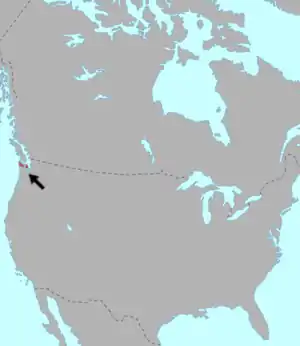Chimakuan languages
The Chimakuan language family consists of one extinct and one severely endangered language spoken in northwestern Washington state, United States, on the Olympic Peninsula. It is part of the Mosan sprachbund, and one of its languages is famous for having no nasal consonants. The two languages were about as close as English and German.
| Chimakuan | |
|---|---|
| Geographic distribution | Olympic Peninsula, Washington |
| Linguistic classification | One of the world's primary language families |
| Subdivisions | |
| Glottolog | chim1311 |
 Pre-contact distribution of Chimakuan languages | |
Family division
Chemakum is now extinct. It was spoken until the 1940s on the east side of the Olympic Peninsula between Port Townsend and Hood Canal. The name Chemakum is an Anglicized version of a Salishan word for the Chimakum people, such as the nearby Twana word čə́bqəb [t͡ʃə́bqəb] (earlier [t͡ʃə́mqəm]).
Quileute is now severely endangered. It is spoken by a few people south of the Makah on the western coast of the Olympic peninsula south of Cape Flattery at La Push and the lower Hoh River. The name Quileute comes from kʷoʔlí·yot' [kʷoʔlíːjotʼ], the name of a village at La Push.
Phonology
The Chimakuan languages have phonemic inventories similar to other languages of the Mosan sprachbund, with three vowels, ejective consonants, uvular consonants, and lateral affricates. However, both languages have typological oddities: Chemakum had no simple velar consonants, and Quileute has no nasal consonants.
Proto-Chimakuan
The (pre-)Proto-Chimakuan sound system contained three vowels, long and short, and lexical stress. It had the following consonants.
| Bilabial | Alveolar | Palatal | Velar | Uvular | Glottal | |||||
|---|---|---|---|---|---|---|---|---|---|---|
| central | lateral | plain | labialized | plain | labialized | |||||
| Nasal | normal | m | n | |||||||
| glottalized | m̰ | n̰ | ||||||||
| Plosive | voiceless | p | t | k | kʷ | q | qʷ | ʔ | ||
| ejective | pʼ | tʼ | kʼ | kʷʼ | qʼ | qʷʼ | ||||
| Affricate | voiceless | t͡s | t͡ʃ | |||||||
| ejective | t͡sʼ | t͡ɬʼ | t͡ʃʼ | |||||||
| Fricative | s | ɬ | ʃ | x | xʷ | χ | χʷ | h | ||
| Approximant | normal | l | j | w | ||||||
| glottalized | l̰ | j̰ | w̰ | |||||||
In Proto-Chimakuan the series [t͡ʃ t͡ʃʼ ʃ] occurred (mostly?) before the vowel /i/. On the other hand, [kʷ kʷʼ xʷ] occurred (mostly?) before the vowels /a, o/. These series may have become separate phonemes before Chimakum and Quileute split, but if so, it seems clear that they had been allophones not long before then.
In Quileute the stress became fixed to the penultimate syllable, though subsequent changes made it somewhat unpredictable, and the glottalized sonorants became allophonic with glottal stop-sonorant sequences and so can no longer be considered phonemic. Open syllables developed long vowels. Perhaps as recently as the late 19th century, the nasals /m n m̰ n̰/ became voiced plosives /b d ʔb ʔd/.
In Chemakum, stressed vowels frequently acquired glottal stops; /t͡ʃ t͡ʃʼ ʃ/ depalatalized to /t͡s t͡sʼ s/, while /k kʼ x/ palatalized to /t͡ʃ t͡ʃʼ ʃ/; sonorants lost their glottalization; and the approximants /j w j̰ w̰/ hardened to /t͡ʃ kʷ/ in the environment of stressed vowels.
References
Bibliography
| Wiktionary has a list of reconstructed forms at Appendix:Proto-Chimakuan reconstructions |
- Andrade, Manuel J. (1933). Quileute. New York: Columbia University Press. (Extract from Handbook of American Indian Languages (Vol. 3, pp. 151–292); Andrade's doctoral dissertation).
- Andrade, Manuel J. (1953). Notes on the relations between Chemakum and Quileute. International Journal of American Linguistics, 19, 212–215.
- Andrade, Manuel J.; & Frachtenberg, Leo J. (1931). Quileute texts. Columbia University contributions to anthropology (Vol. 12). New York: Columbia University Press.
- Boas, Franz. (1892). Notes on the Chemakum language. American Anthropologist, 5, 37–44.
- Campbell, Lyle. (1997). American Indian languages: The historical linguistics of Native America. New York: Oxford University Press. ISBN 0-19-509427-1.
- Mithun, Marianne. (1999). The languages of Native North America. Cambridge: Cambridge University Press. ISBN 0-521-23228-7 (hbk); ISBN 0-521-29875-X.